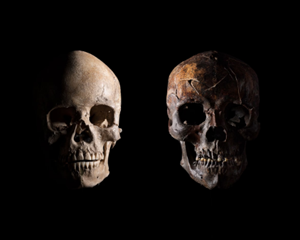Mounting an archaeological dig in Niger is complicated.
要在尼日尔展开考古挖掘工作是很复杂的事。
The country is larger than France, Germany, and Italy combined, and most of it is barren stretches of desert with little or no road access.
这个国家比法国、德国和意大利加起来还要大,而绝大部分是无尽延伸的荒芜沙漠,几乎没有道路抵达。
Since gaining independence from France in 1960, Niger has endured a series of military coups and ethnic conflicts, has struggled to diversify its agriculture-based economy, and suffers from chronic food and medicine shortages.
尼日尔自从1960年从法国独立出来后,经历了一连串军事政变和种族冲突,一直很难让农业为主的经济更加多元化,也苦于长久以来的食物和医药短缺。
As a result, requests by foreign scientists to explore its remote eastern deserts -- which border Libya and Chad, nations wrestling with their own internal conflicts -- must wind their way through a lengthy government approval process.
因此,外国科学家要申请探索尼日尔的偏远东方沙漠,必须历经冗长的政府批准程序,该沙漠与利比亚和乍得接壤,这两个国家都在努力解决内部冲突。
"It's difficult for many people in Niger to realize the value of the dinosaur fossils and the artifacts we have," Sidi Amar Taoua, a tour guide from the desert city of Agadez, told me.
“对尼日尔的很多人来说,了解恐龙化石和我们手上文物的价值是很困难的事。”西迪·阿玛·突瓦对我说,他是一名导游,来自沙漠城市阿加德兹。
"Most people are worried about access to clean water, schools for their children, job opportunities, and security."
“大多数人烦恼的是如何取得干净水源、让孩子上学、工作机会,以及安全。”
In the north, the country's colonial past and the large uranium mines run by French companies have colored some Nigeriens' views about outsiders coming to dig in their deserts.
在尼日尔北部,殖民历史和法国公司经营的大型铀矿场,影响了一些尼日尔人对跑来他们沙漠挖掘的外国人的观感。
"Some people think we're looking for oil or gold," Dindine told me.
“有些人认为我们是来找石油或黄金的。”丁迪内对我说。
Further suspicions were raised when the U.S. military built a large drone base in Agadez to run surveillance missions across the region.
后来,美军在阿加德兹兴建大型的无人机基地,以便从那里对整个区域执行监测任务,更引发进一步的质疑。
After the initial discovery of Gobero, Sereno was able to organize four full expeditions to the site and carve out time from five other dinosaur excavations to revisit it.
自从发现格伯托之后,塞雷诺组织了四次远征队全面探索这个遗址,并且在挖掘其他五个恐龙化石遗址的同时抽空重返格伯托。
Some years he wasn't able to travel because of security issues -- a Tuareg rebellion and threats from terrorist groups that had moved into parts of Niger and neighboring Mali.
几年来,由于安全问题--图阿雷格人的叛乱以及恐怖组织进入尼日尔部分地区和邻国马里带来的威胁,使得他都无法前往。
Each time the expeditions returned and set up their tents near the ancient lake bed, the scientists wondered what they'd find.
远征队每一次返回格伯托,在古代湖床附近搭起帐棚时,科学家都很好奇会看到什么改变。
Had the desert winds finally carried away the small dunes? Had curious nomads rummaged the site? Or had it been ransacked by looters? But each time, new discoveries were exposed.
沙漠狂风是否终于把小沙丘吹走了?好奇的游牧人是否翻找过遗址?或者已经被盗掘者洗劫一空?但每一次,他们都揭开了全新的发现。

There were ceramic pots inscribed with various designs, a warthog's tusk, the skeletons of a toad and a python.
有雕刻了各种图样的陶盆、一根疣猪的獠牙,还有一只蟾蜍和一条蟒蛇的骸骨。
There were large fishhooks and harpoon points, including one made from a crocodile jawbone.
有大型的鱼钩和鱼叉的尖端,其中一件是用鳄类的下颚骨裂成。
There were finely worked arrowheads made from green felsite, red jasper, milky white quartz, even petrified wood; ostrich eggshell beads; and pendants made from hippo ivory and amazonite.
有作工细致的箭头,用绿色霏细岩、红碧玉、乳白色石英甚至石化木打造而成;有用鸵鸟蛋壳制作的珠子;还有用河马牙齿和天河石制成的坠子。
Several prehistoric middens, or garbage dumps, overflowed with bones from Nile perch and catfish and included a stack of mussel shells.
有好几个史前的贝冢,也就是垃圾场,里面满是尼罗河鲈鱼和鲇鱼的骨头,也包括一堆贻贝的贝壳。
Even the sand contained evidence -- pollen from palm and fig trees, cattails, and other plants associated with wet areas.
就连沙子也含有证据:里面有花粉,来自棕榈树和无花果树、香蒲,以及与潮湿地区有关的其他植物。
But the finds that left team members speechless were the burials.
但是让团队成员目瞪口呆的发现,是坟墓。
"We find every age -- old people, middle age, teenagers, children, infants," Sereno said.
“我们发现了各年龄层--老年人、中年人、青少年、孩童、婴儿。”塞雷诺说。
Radiocarbon dating puts the oldest burial, a six-foot-two man posed in a tight crouch, at around 9,500 years ago, near the beginning of the Green Sahara.
放射性碳定年法所标定最古老的坟墓里埋葬着身高6英尺2英寸的男子,呈现紧紧蜷缩的姿势,年代约在9500年前,接近绿色撒哈拉时期刚开始的时候。
The most recent burial, a 10-year-old girl wearing a large hippo ivory bracelet, occurred about 4,900 years ago -- a span of roughly five millennia.
最近期的坟墓里有个十岁女孩,戴着很大的河马牙齿手镯,大约存在于4900年前,前后横跨约5000年。
"That's about the length of time from the first Egyptian pharaoh to my grandfather," Sereno said, "all in this one small area."
“那样的时间跨度大约是从第一位埃及法老到我祖父的年代,”塞雷诺说,“全都在这一个小小的区域。”
The burials tended to fall into two broad categories.
这些坟墓大致分成两大类。
In the older ones, the bodies were buried in the same manner as the six-foot-two man, with arms held close to the torso and knees pulled up tightly to the ribs and spine, so that the skeletons resemble collapsed accordions.
在较古老的坟墓里,遗体的埋葬方式都如同那位身高6英尺2英寸的男子,两只手臂紧靠着身躯,膝盖往上紧紧抵住肋骨和脊椎,因此骸骨很像折叠起来的手风琴。
One theory holds that some of these had been interred tightly bundled, possibly in animal hides.
有一个理论认为,有些遗体入葬时可能是以兽皮紧密包裹起来的。
Idé, head of archaeology for Niger's Research Institute in Human Sciences, explained that the dates of these burials suggest these people were part of what archaeologists have named the Kiffian, a fisher-forager culture that ended about 8,000 years ago.
伊德是尼日尔的人类科学研究院的考古组组长,他说根据这些坟墓的定年结果,这些人属于考古学家已命名的“基弗文化”,是一种捕鱼探食文化,大约结束于8000年前。
Around that time, the burials at Gobero were flooded and remained submerged for several centuries.
大约在那时,格伯托的坟墓遭到洪水淹没,浸在水中好几个世纪之久。
The younger burials, he said, belong to the Tenerean people, who arrived about a thousand years after the Kiffian burials ceased.
他说,比较新的坟墓属于特内里安人,在这里已经没有基弗文化墓葬的大约1000年后,他们抵达了此地。
Based on evidence found at other sites, some scholars believe the Tenereans were among early herding cultures that started to appear in the latter part of the Green Sahara period.
根据其他遗址发现的证据,有些学者认为特内里安人属于早期的游牧文化,在绿色撒哈拉时期的晚期开始出现。
At Gobero, almost all the Tenereans were positioned on their sides, as though asleep.
在格伯托,几乎所有的特内里安人都安置成侧躺,彷佛睡着了。
In one burial, a woman holds a newborn, the pair possibly succumbing during childbirth.
在一个坟墓里,一名女子抱着新生儿,这对母子可能是生产时死去。
A 12-year-old boy lies with his hands clasped under his head like a pillow, a tiny bird skeleton clutched in his right hand.
一名12岁男孩躺着,双手像枕头一样扣在头下,右手还抓着一具小小的鸟类骸骨。
Nearby, a man appears to have two teeth filed fanglike points. Elsewhere, a man sits on a large turtle shell; another wears a ceramic pot on his head.
附近有名男子有两颗牙齿磨锉成长牙尖端的模样。而在其他地方,一名男子坐在很大的龟壳上;另一名男子的头上放着陶壶。



